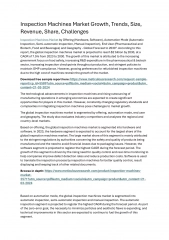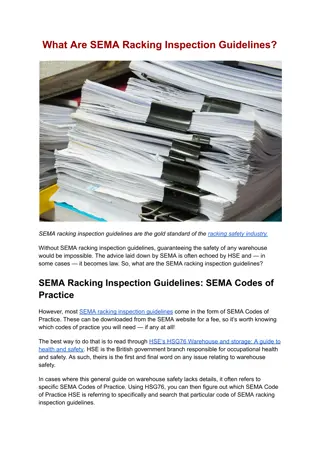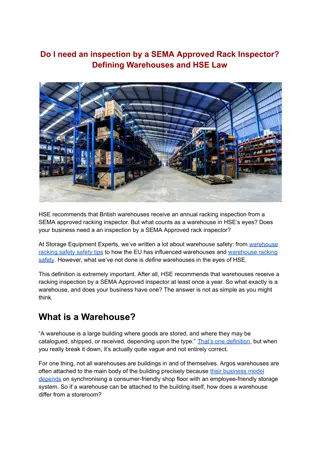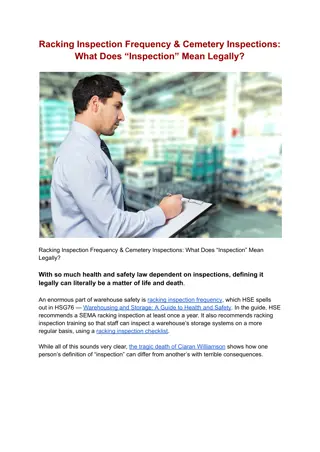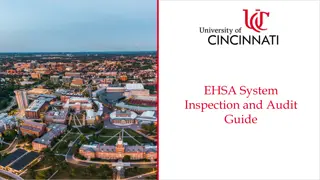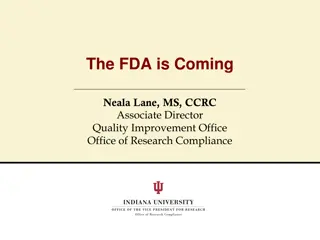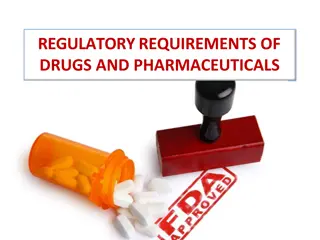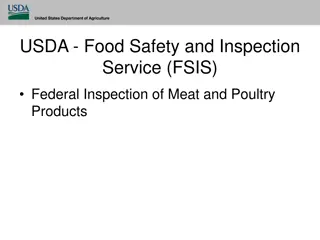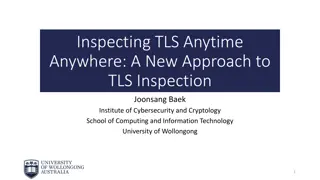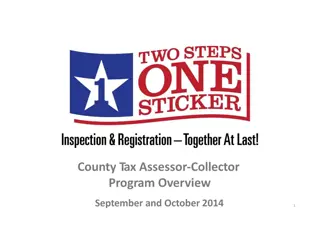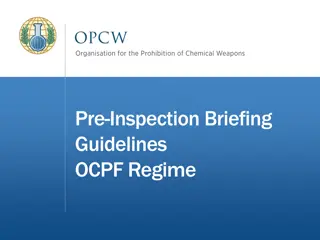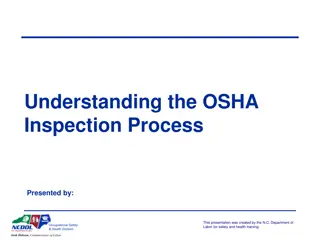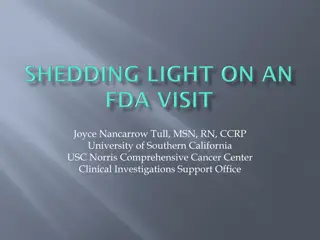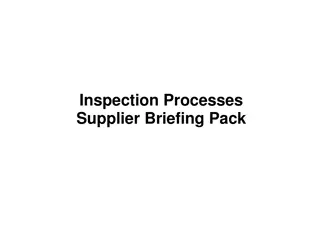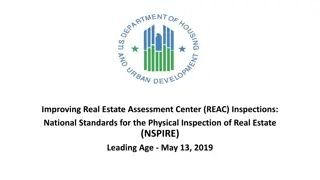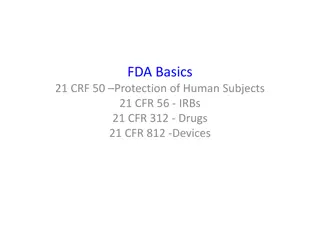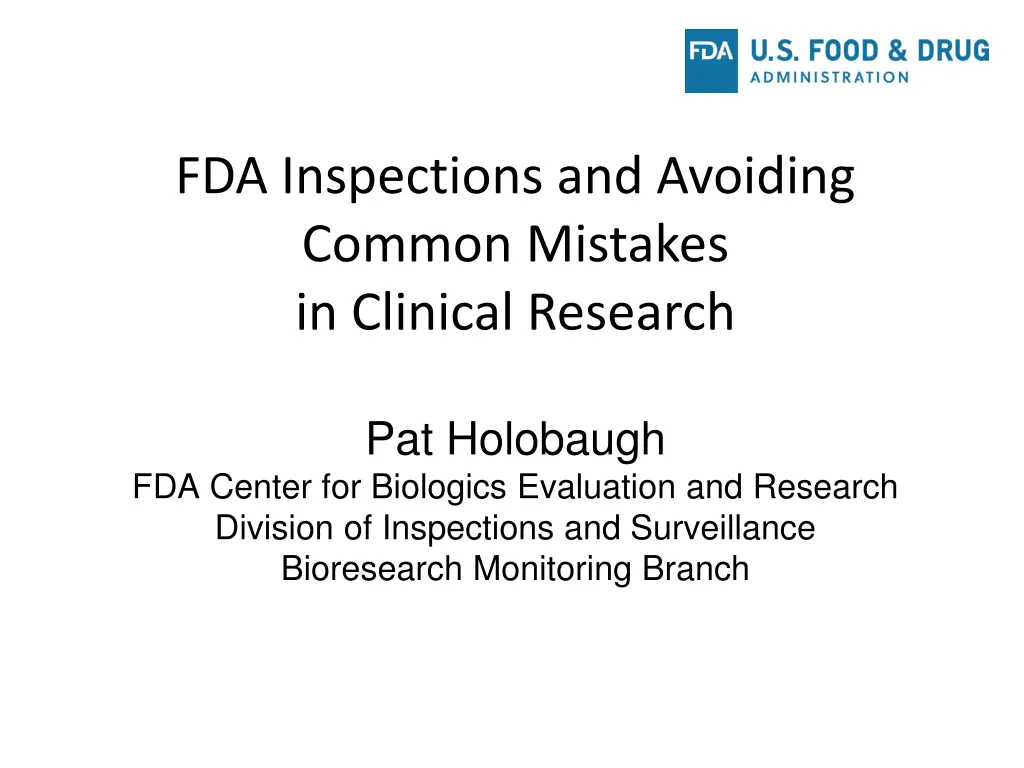
FDA Inspections and Common Mistakes in Clinical Research
"Learn about FDA inspections in clinical trials, common mistakes to avoid, and actions to prevent study problems. Explore the Bioresearch Monitoring Program, inspection logistics, and review of records by the FDA."
Download Presentation

Please find below an Image/Link to download the presentation.
The content on the website is provided AS IS for your information and personal use only. It may not be sold, licensed, or shared on other websites without obtaining consent from the author. If you encounter any issues during the download, it is possible that the publisher has removed the file from their server.
You are allowed to download the files provided on this website for personal or commercial use, subject to the condition that they are used lawfully. All files are the property of their respective owners.
The content on the website is provided AS IS for your information and personal use only. It may not be sold, licensed, or shared on other websites without obtaining consent from the author.
E N D
Presentation Transcript
FDA Inspections and Avoiding Common Mistakes in Clinical Research Pat Holobaugh FDA Center for Biologics Evaluation and Research Division of Inspections and Surveillance Bioresearch Monitoring Branch
Objectives Describe how FDA inspects clinical trials Discuss the most common mistakes FDA finds during inspections Suggest actions to prevent study problems 2
FDAs Bioresearch Monitoring Program (BIMO) Inspects.... Clinical Investigators Sponsors/Monitors/Contract Research Organizations Institutional Review Boards Nonclinical Laboratories 3
When are BIMO Inspections Conducted ? Submission of marketing applications NDA/BLA/PMA/other Referrals from Center staff Referrals from other parts of FDA Complaints from sponsors, IRBs, and consumers Surveillance of ongoing studies under IND / IDE 4
FDA Inspection Assignment Package Background information Protocol Signed Form FDA 1572 (drug/biologic) or investigator agreement (medical device) Listings of individual subjects data Adverse events Informed Consent Form Number of subjects enrolled Site specific information (deviations, outcomes, etc.) 5
Inspection Logistics The FDA investigator will call to announce the inspection and request that ALL documents should be available for the inspection. You arrange for a place for the FDA investigator to work and access to a copier. The FDA investigator is required to show credentials to the most responsible person, and present a Form FDA-482 Notice of Inspection for domestic inspections. There is an opening interview. The FDA investigator will review documents. Please make time each day to meet with the FDA investigator to answer questions. 6
FDA Review of Records Protocol and amendments Informed consent forms Drug accountability records Correspondence with Sponsor and IRB IRB Approvals & Progress reports & Adverse Event reports Case Report Forms How data are recorded and corrected Compare to source documents Supporting Files (Source Documentation) Hospital/clinic chart, labs, diaries, etc. 7
Exit Interview Discuss inspection findings May issue a Form FDA-483 Inspectional Observations Represents investigator s observations of deviations from federal regulations for clinical investigators; is not a final FDA decision. Your verbal responses to Form FDA 483 Your letter responding to the issues should be received within 15 days to be considered in deciding FDA s actions. 8
After the Inspection... The inspection report is written by the FDA investigator and sent to the Center. The Center evaluates the report and determines the corrective action, and classifies the inspection: NAI = No Action Indicated, or VAI = Voluntary Action Indicated, or OAI = Official Action Indicated We write a letter to the inspected party following most inspections OAI inspections have consequences (warning letter, etc.) 9
Most Significant Violations Enrollment of ineligible subjects Violation of protocol affecting subject safety Extensive data corrections and questionable changes Inadequate oversight of study personnel Inappropriate delegation of authority Poor oversight of satellite sites No informed consent Failure to communicate with IRB Falsification 10
Sponsors are Required to Monitor the Studies and Obtain Compliance Monitoring should look for most common violations: Failed to follow protocol requirements Inadequate case histories Discrepancies between source records and case report form Inadequate drug/device accountability records Enrolled ineligible subjects And Indicators of Fraud 11
The Protocol Violation Spectrum Minor a missed lab test, a missed visit Major ineligible subject enrolled safety or efficacy assessments not done did not report serious adverse events to IRB 12
Significance of Violations Do the violations ...affect rights, safety, or welfare of subjects? ...directly impact integrity of data set? ...indicate systemic problems within the study = sponsor problems? ...indicate problems with the investigator that extend to other studies at that site? Did the sponsor report the problems to FDA? 13
Suggestions to Improve Protocol Compliance Review and understand the protocol Identify any procedures in the protocol that differ from standard practice at your establishment Thoroughly train study staff Use well-designed study-specific forms for documentation 14
Suggestions to Improve Protocol Compliance Identify study-specific procedures and at what points of the study they are required; develop a plan/schedule Perform study-required procedures and visits within the required window A large number of out-of-window procedures/visits may indicate too tight a window or poor planning/scheduling 15
Suggestions to Improve Protocol Compliance Carefully review amendments Inform all study personnel of any changes in the amendment Track versions of the protocol and use the correct version 16
Suggestions to Improve Protocol Compliance Document all protocol deviations Review the deviations for trends Trends may indicate re-training or a protocol amendment is necessary Use the deviations to develop corrective actions to prevent future occurrence 17
Ways to Prevent Enrollment of Ineligible Subjects Protocol criteria should be clear, not subject to differing interpretations Train all study personnel involved in determining eligibility to understand the inclusion and exclusion criteria Use a form that lists each criterion to assist during subject assessment 18
Ways to Prevent Enrollment of Ineligible Subjects Do not rely on exemptions from the sponsor If there are numerous exemptions, perhaps the protocol inclusion or exclusion criteria should be revised Sponsor s waiver of entry criterion should be in writing and prospective Consult with IRB for its instructions about waivers 19
Adequate and Accurate Case Histories Record keeping errors may be minor, or they might impact the safety or welfare of the subject, impact the study data, or undermine the clinical trial process Examples: extensive or uncorroborated data corrections adverse event severity is under-reported to sponsor or IRB Adverse events are reported LATE to sponsor or IRB 20
Suggestions to Improve Recordkeeping Make sure the staff know how to use the sponsor s computer system and understand the expectations Use a consistent format to document all aspects of the subject s evaluation and treatment Keep records organized and complete Develop a system to track and maintain files 21
FDA has observed that sponsors and monitors may have conflicting written and verbal instructions for how they want investigators to prepare and maintain case histories, and perform corrections. 22
Where is the Term Source Data Defined? NOT defined in 21 CFR 312 (investigational drugs) or 812 (investigational devices) See Nonclinical Laboratory regulations 21 CFR 58.3(k) raw data 21 CFR 58.130(e) describes how data are to be recorded, corrected, and describes automated systems. 23
Elements of Documentation Integrity Attributable Legible/readable Contemporaneous Original Accurate 24
Common Informed Consent Problems Study-specific procedures are performed before informed consent is obtained. The informed consent discussion is conducted by someone who is not authorized. What is the IRB s intent for the investigator s signature on the form if another person discusses the study? What if the investigator signs later? What is the sponsor s/IRB s expectation for re-consent when the consent form is revised? 25
Clinical Investigator Supervision and Authority Verify credentials is your study coordinator a nurse with a only a high school education? How will you (CI) supervise the conduct of sub-investigators, particularly if they are located at a distance? 26
Clinical Investigator Supervision and Authority What authority do you have over the personnel assisting in the trial? Can you fire a study coordinator or other personnel employed by the sponsor? How do you report inadequate performance of a monitor hired by the sponsor? 27
Inappropriate Delegation to Sub-investigators Investigator individual who actually conducts an investigation (i.e., under whose immediate direction the drug is administered or dispensed to subjects. How can you directly supervise subinvestigators who are working in other states or across the country? This is a BIG challenge for study coordinators and support staff Sponsor must ensure that the clinical investigator controls the study 28
Test Article Accountability Records should be sufficient to show: Subjects received proper dose/device Which dose/vial/device was provided to which subject and when Accountability for all investigational product Product was shipped, received, and stored at the proper temperature and conditions 29
Suggestions for Investigators to Prevent Noncompliance - BEFORE - Understand what you are responsible for... .....And get training Document the delegation of duties Develop forms or checklists to make sure all screening tests and study visit activities are performed...if not provided by the sponsor Don t overextend yourself with too many concurrent projects 30
Suggestions to Prevent Noncompliance - BEFORE - Develop a plan for organizing records Clearly understand what records are to be maintained and how they should be completed Original source data for critical study endpoints Use your site s existing record-keeping system as much as possible, discuss this with the sponsor up front All records should meet the ALCOA test Train study staff before the study starts....and train replacements when staff leave 31
Suggestions to Prevent Noncompliance - During - Track dates when reports are due to the IRB and the sponsor Promptly report protocol violations to IRB and sponsor. Obtain written approval from the sponsor before you do something that is outside of the protocol Verify that delegated duties are performed Work with monitors Correct small problems before they grow Question unusual results 32
Suggestions to Prevent Noncompliance - After - Organize the study records --- So non-study staff can find them To show what a good job you did To fulfill record retention requirements For possible FDA inspection (years later - depending on the sponsor and phase of the research) 33
CBERs Bioresearch Monitoring Branch Branch email is CBERBIMONotification@fda.hhs.gov FAX 301-595-1304 Branch Chief is Pat Holobaugh 240-402-8955 patricia.holobaugh@fda.hhs.gov

